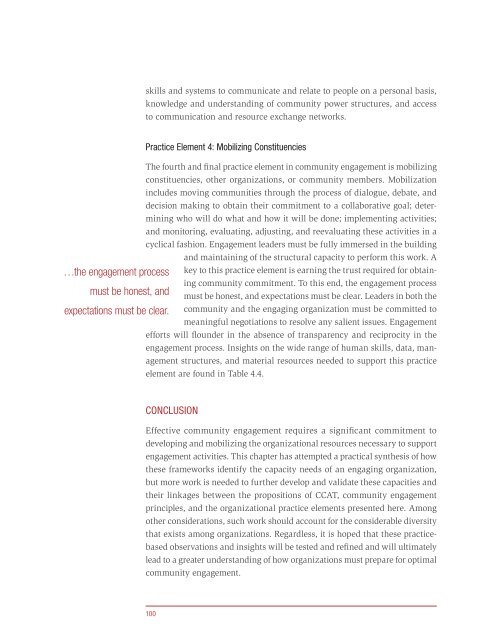Principles of Community Engagement (Second Edition)
Principles of Community Engagement (Second Edition)
Principles of Community Engagement (Second Edition)
Create successful ePaper yourself
Turn your PDF publications into a flip-book with our unique Google optimized e-Paper software.
…the engagement process<br />
must be honest, and<br />
expectations must be clear.<br />
skills and systems to communicate and relate to people on a personal basis,<br />
knowledge and understanding <strong>of</strong> community power structures, and access<br />
to communication and resource exchange networks.<br />
Practice Element 4: Mobilizing Constituencies<br />
The fourth and final practice element in community engagement is mobilizing<br />
constituencies, other organizations, or community members. Mobilization<br />
includes moving communities through the process <strong>of</strong> dialogue, debate, and<br />
decision making to obtain their commitment to a collaborative goal; determining<br />
who will do what and how it will be done; implementing activities;<br />
and monitoring, evaluating, adjusting, and reevaluating these activities in a<br />
cyclical fashion. <strong>Engagement</strong> leaders must be fully immersed in the building<br />
and maintaining <strong>of</strong> the structural capacity to perform this work. A<br />
key to this practice element is earning the trust required for obtaining<br />
community commitment. To this end, the engagement process<br />
must be honest, and expectations must be clear. Leaders in both the<br />
community and the engaging organization must be committed to<br />
meaningful negotiations to resolve any salient issues. <strong>Engagement</strong><br />
efforts will flounder in the absence <strong>of</strong> transparency and reciprocity in the<br />
engagement process. Insights on the wide range <strong>of</strong> human skills, data, management<br />
structures, and material resources needed to support this practice<br />
element are found in Table 4.4.<br />
CONCLUSION<br />
Effective community engagement requires a significant commitment to<br />
developing and mobilizing the organizational resources necessary to support<br />
engagement activities. This chapter has attempted a practical synthesis <strong>of</strong> how<br />
these frameworks identify the capacity needs <strong>of</strong> an engaging organization,<br />
but more work is needed to further develop and validate these capacities and<br />
their linkages between the propositions <strong>of</strong> CCAT, community engagement<br />
principles, and the organizational practice elements presented here. Among<br />
other considerations, such work should account for the considerable diversity<br />
that exists among organizations. Regardless, it is hoped that these practicebased<br />
observations and insights will be tested and refined and will ultimately<br />
lead to a greater understanding <strong>of</strong> how organizations must prepare for optimal<br />
community engagement.<br />
100

















